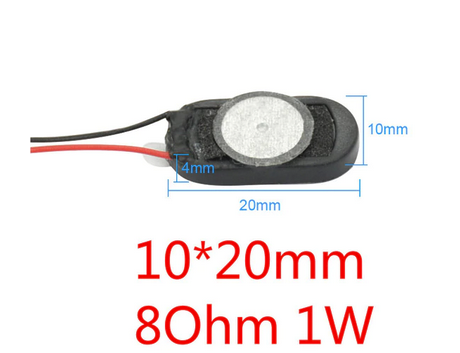As I was scouring the Internet for some good Geiger Counter sounds, I stumbled upon this wonderful piece of code by [Samuelvdv] who uses a proprietary indoor positioning Arduino shield to make the "Geiger counter" go off when approaching specific locations. If I could use (part of) this code to perhaps track a BLE beacon, that would allow me to create "radioactive" props for use with the Pip Boy.
In his article, he also links to an older project by [Jeff Haas] that uses a 1 Ohm speaker. Luck has it, I ordered a couple of those for another project of mine!
 I managed to test out the sounds the "Geiger counter" makes. The speakers are super tiny, and only uses up one GPIO-pin and connects to GND.
I managed to test out the sounds the "Geiger counter" makes. The speakers are super tiny, and only uses up one GPIO-pin and connects to GND. The sound resonates pretty well in the Rad Module, so I think we can also consider the sound part of it all a big success! Now to cobble and code everything together!
I'm posting the code here with attribution just so I don't lose it myself ;).
// Geiger Counter - simulated sound effect by Jeff Haas
// Source: https://www.instructables.com/id/How-To-Make-A-Fake-Geiger-Counter/
// Connections:
// Arduino Pin 10 is toggled to create audio sound effect and goes to LM386 amp
// Arduino Pin 9 is the activate button, which must have a pull-up resistor on it
// An LED (which is optional) can connect to Pin 8 (and needs a current-limiting resistor and connection to ground)
// FINAL port on 5/25/2012
#include <inttypes.h>
#include <avr/io.h>
#include <avr/interrupt.h>
#include <avr/sleep.h>
#include <stdlib.h>
// #include "iocompat2.h" Not needed in Arduino environment
// #include "pin_macros.h" Not needed in Arduino environment
#define INIT_TIMER_COMP 0xffff
#define LOWBYTE(val) ((uint8_t)((val) & 0xff))
#define HIGHBYTE(val) ((uint8_t)(((val) & 0xff00) >> 8))
#define B_DATA_PORT_MASK (_BV(DDB0))
int foo(void) {
return 2;
}
void toggle_b2(void)
{
PORTB ^= _BV(PORTB2);
}
void led_out (uint8_t val)
{
unsigned char tval;
tval = PORTB & _BV(PORTB2);
tval |= ~val & B_DATA_PORT_MASK;
PORTB = tval;
}
void stop_timer1 (void)
{
TCCR1B = TCCR1B & ~(_BV(CS10) | _BV(CS11) | _BV(CS12));
}
void start_timer1 (void)
{
TCCR1B |= _BV(WGM12);
TCCR1B |= _BV(CS12); /* clock prescale divide by 8 */ // Original non-Arduino value was CS11, in Arduino environment, set to (CS12), which is 256.
}
ISR (TIMER1_OVF_vect)
{
led_out(0x1);
}
void set_compare_timer1 (uint16_t val)
{
OCR1AH = HIGHBYTE(val);
OCR1AL = LOWBYTE(val);
}
typedef enum {
UP,
DOWN,
} SVAL;
#define INITSHIFT 0
int sit = (5<<INITSHIFT);
int shift = INITSHIFT;
ISR (TIMER1_COMPA_vect)
{
static unsigned int delay = 0;
static SVAL state = DOWN;
int in = PINB;
cli();
stop_timer1();
toggle_b2();
if (in & 0x2) {
state = DOWN;
led_out(0);
} else {
state = UP;
led_out(1);
}
delay = (rand() & 0xDEA8); // Maximum length of the delay between clicks, a random number. Original value was 0xffff (65536).
if (delay < 0x40) {
delay = 0x40;
}
if (sit-- <= 0) {
switch (shift) {
case 0:
if (state == UP) {
shift = 2;
sit = (5);
} else {
shift = 0;
sit = 1;
}
break;
case 1:
case 2:
if (state == UP) {
shift = 3;
sit = 1;
} else {
sit = 1;
shift = 0;
}
break;
case 3:
case 4:
if (state == UP) {
sit = 1;
shift = 3;
} else {
sit = (10);
shift = 1;
}
break;
}
}
if (shift == 0) {
set_compare_timer1(delay<<2);
} else {
set_compare_timer1(delay>>shift);
}
start_timer1();
led_out(shift);
sei();
}
void
ioinit (void)
{
DDRB = B_DATA_PORT_MASK | _BV(DDB2);
PORTB = 0;
TCCR1A = 0;
TCCR1B = 0;
set_compare_timer1(0x4000);
TCCR1A = 0;
TCCR1B |= _BV(WGM12);
TCCR1B |= _BV(CS11);
}
#define JVAL 100000;
int
main (void)
{
ioinit ();
srandom(0x12345678);
set_sleep_mode(SLEEP_MODE_IDLE);
TIMSK1 = _BV (OCIE1A);
cli();
sei ();
sleep_enable();
sei();
for (;;) {
sleep_cpu();
}
return (0);
}
 Vincent
Vincent
Discussions
Become a Hackaday.io Member
Create an account to leave a comment. Already have an account? Log In.